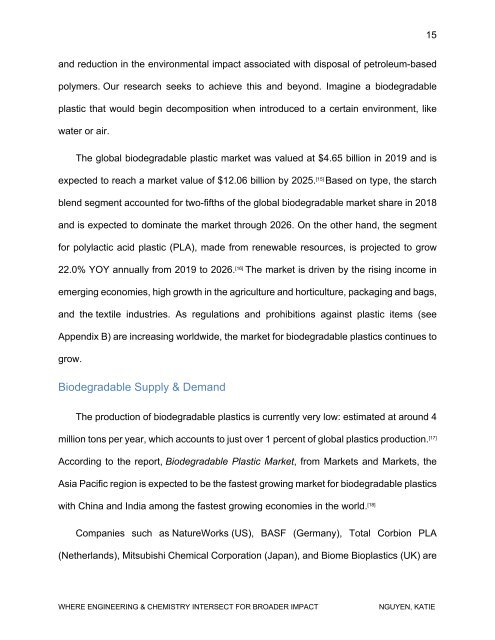Where Engineering & Chemistry Intersect for Broader Impact
Currently, many biodegradable products in the market are bio-based, such as polysaccharides, proteins, and lipids, and are focused on conventional plastic applications. This approach to production of biodegradable plastics, however, is facing mounting challenges due to high cost, weaker performance, and environmental issues. In addition, several biodegradable plastics have proven to break down quickly under specific, simulated environmental conditions, but they may not be effectively degradable under natural conditions. As a result of these challenges and many more, there exists a gap in the market. Our Project Affiliates, Dr. Son and Dr. Krueger, aim to bridge this gap by pursuing a biodegradable plastic that better addresses the aforementioned challenges, investigating a prototype plastic with predictable degradation and mechanical properties. In the spirit of interdisciplinary innovation, they seek to develop a joint chemical and engineering approach to biodegradable plastics for broader impact.
Currently, many biodegradable products in the market are bio-based, such as polysaccharides, proteins, and lipids, and are focused on conventional plastic applications. This approach to production of biodegradable plastics, however, is facing mounting challenges due to high cost, weaker performance, and environmental issues. In addition, several biodegradable plastics have proven to break down quickly under specific, simulated environmental conditions, but they may not be effectively degradable under natural conditions. As a result of these challenges and many more, there exists a gap in the market.
Our Project Affiliates, Dr. Son and Dr. Krueger, aim to bridge this gap by pursuing a biodegradable plastic that better addresses the aforementioned challenges, investigating a prototype plastic with predictable degradation and mechanical properties. In the spirit of interdisciplinary innovation, they seek to develop a joint chemical and engineering approach to biodegradable plastics for broader impact.
Create successful ePaper yourself
Turn your PDF publications into a flip-book with our unique Google optimized e-Paper software.
15<br />
and reduction in the environmental impact associated with disposal of petroleum-based<br />
polymers. Our research seeks to achieve this and beyond. Imagine a biodegradable<br />
plastic that would begin decomposition when introduced to a certain environment, like<br />
water or air.<br />
The global biodegradable plastic market was valued at $4.65 billion in 2019 and is<br />
expected to reach a market value of $12.06 billion by 2025. [15] Based on type, the starch<br />
blend segment accounted <strong>for</strong> two-fifths of the global biodegradable market share in 2018<br />
and is expected to dominate the market through 2026. On the other hand, the segment<br />
<strong>for</strong> polylactic acid plastic (PLA), made from renewable resources, is projected to grow<br />
22.0% YOY annually from 2019 to 2026. [16] The market is driven by the rising income in<br />
emerging economies, high growth in the agriculture and horticulture, packaging and bags,<br />
and the textile industries. As regulations and prohibitions against plastic items (see<br />
Appendix B) are increasing worldwide, the market <strong>for</strong> biodegradable plastics continues to<br />
grow.<br />
Biodegradable Supply & Demand<br />
The production of biodegradable plastics is currently very low: estimated at around 4<br />
million tons per year, which accounts to just over 1 percent of global plastics production. [17]<br />
According to the report, Biodegradable Plastic Market, from Markets and Markets, the<br />
Asia Pacific region is expected to be the fastest growing market <strong>for</strong> biodegradable plastics<br />
with China and India among the fastest growing economies in the world. [18]<br />
Companies such as NatureWorks (US), BASF (Germany), Total Corbion PLA<br />
(Netherlands), Mitsubishi Chemical Corporation (Japan), and Biome Bioplastics (UK) are<br />
WHERE ENGINEERING & CHEMISTRY INTERSECT FOR BROADER IMPACT<br />
NGUYEN, KATIE














